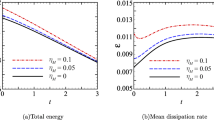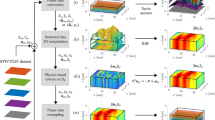Abstract
We extend the vortex-surface field (VSF), a Lagrangian-based flow diagnostic method, to experimental data of the tomographic particle image velocimetry (Tomo-PIV). The boundary-constraint method is applied to construct the VSF from the instantaneous Tomo-PIV velocity field in the wake flow of a ramp vortex generator (VG) at a moderate Reynolds number. Under finite experimental noises, the VSF construction has satisfactory errors, showing the applicability of the VSF to visualize Tomo-PIV data. From a Lagrangian viewpoint, the VSF is used to elucidate the formation and evolution of coherent structures in the VG wake. The initially planar vortex surfaces consisting of undisturbed vortex lines in the laminar boundary layer are first lifted as the flow past over the VG. Subsequently, the bulge-like outer vortex surfaces in the near wake of VG generate a strong shear layer, and the near-wall inner vortex surface downstream to VG is lifted by the streamwise vortices formed from the lateral VG edges. Further downstream, the outer vortex surfaces break up into arch- or hairpin-like structures due to the Kelvin–Helmholtz instability. The geometric deformation of vortex surfaces is quantified by conditional means of the VSF gradient.













Similar content being viewed by others
Data availability
Not applicable.
References
Acarlar MS, Smith CR (1987) A study of hairpin vortices in a laminar boundary layer. Part 1. Hairpin vortices generated by a hemisphere protuberance. J Fluid Mech 175:1–41
Atkinson C, Soria J (2009) An efficient simultaneous reconstruction technique for tomographic particle image velocimetry. Exp Fluids 47:563–578
Babinsky H, Li Y, Pitt-Ford CW (2009) Microramp control of supersonic oblique shock-wave/boundary-layer interactions. AIAA J 47:668–675
Belkhou H, Russeil S, Dbouk T et al (2019) Large eddy simulation of boundary layer transition over an isolated ramp-type micro roughness element. Int J Heat Fluid Flow 80:108492
Blinde PL, Humble RA, van Oudheusden BW et al (2009) Effects of micro-ramps on a shock wave/turbulent boundary layer interaction. Shock Waves 19:507–520
Brachet ME, Meiron DI, Orszag SA et al (1983) Small-scale structure of the Taylor-Green vortex. J Fluid Mech 130:411–452
Casacuberta J, Groot KJ, Ye Q et al (2020) Transitional flow dynamics behind a micro-ramp. Flow Turbul Combust 104:533–552
Elsinga GE, Scarano F, Wieneke B et al (2006) Tomographic particle image velocimetry. Exp Fluids 41:933–947
Fernández Gámiz U (2013) Fluid dynamic characterization of vortex generators and two-dimensional turbulent wakes. PhD thesis, Polytechnic University of Catalonia
Gillissen JJJ, Bouffanais R, Yue DKP (2019) Data assimilation method to de-noise and de-filter particle image velocimetry data. J Fluid Mech 877:196–213
Han Z, Yang Y (2022) Criteria of tracking vortex surfaces in turbulent-like flows. Adv Aerodyn 4:6
Hao J, Xiong S, Yang Y (2019) Tracking vortex surfaces frozen in the virtual velocity in non-ideal flows. J Fluid Mech 863:513–544
He C, Wang P, Liu Y et al (2022) Flow enhancement of tomographic particle image velocimetry measurements using sequential data assimilation. Phys Fluids 34:035101
Henze M, von Wolfersdorf J, Weigand B et al (2011) Flow and heat transfer characteristics behind vortex generators-a benchmark dataset. Int J Heat Fluid Flow 32:318–328
Hunt JCR, Wray AA, Moin P (1988) Eddies, streams, and convergence zones in turbulent flows. Cent Turbul Rep CTR 88:193–208
Jeong J, Hussain F (1995) On the identification of a vortex. J Fluid Mech 285:69–94
Jiang GS, Shu CW (1996) Efficient implementation of weighted ENO schemes. J Comput Phys 126:202–228
Kitzhofer J, Brücker C, Pust O (2009) Tomo PTV using 3D scanning illumination and telecentric imaging. In: Proceedings of the 8th international symposium on particle image velocimetry - PIV09, Melbourne, Victoria, Australia
Klebanoff PS (1955) Characteristics of turbulence in a boundary layer with zero pressure gradient. NACA report, No, p 1247
Li Q, Liu C (2010) LES for supersonic ramp control flow using MVG at M=2.5 and Re=1440. AIAA Paper 2010-592
Lin J (1999) Control of turbulent boundary-layer separation using micro-vortex generators. AIAA Paper 99-3404
Peng N, Yang Y, Wu J et al (2021) Mechanism and modelling of the secondary baroclinic vorticity in the Richtmyer–Meshkov instability. J Fluid Mech 911:A56
Robinson SK (1991) Coherent motions in the turbulent boundary layer. Annu Rev Fluid Mech 23:601–639
Ruan S, Xiong S, You J et al (2022) Generation of streamwise helical vortex loops via successive reconnections in early pipe transition. Phys Fluids 34:054112
Scarano F (2012) Tomographic PIV: principles and practice. Meas Sci Technol 24:012001
Sun Z, Schrijer F, Scarano F et al (2012) The three-dimensional flow organization past a micro-ramp in a supersonic boundary layer. Phys Fluids 24:055105
Sun Z, Schrijer FFJ, Scarano F et al (2014) Decay of the supersonic turbulent wakes from micro-ramps. Phys Fluids 26:025115
Tani I (1969) Boundary-layer transition. Annu Rev Fluid Mech 1:169–196
Taylor H D (1947) The elimination of diffuser separation by vortex generators. United Aircraft Corporation Report No. R-4012-3
Tong W, Yang Y, Wang S (2021) Estimating thrust from shedding vortex surfaces in the wake of a flapping plate. J Fluid Mech 920:A10
Velte C (2009) Characterization of vortex generator induced flow. PhD thesis, DTU
Von Doenhoff AE, Braslow AL (1961) The effect of distributed surface roughness on laminar flow. In: Lachmann G (ed) Boundary layer and flow control. Pergamon, pp 657–681
Wang C, Gao Q, Wang H et al (2016) Divergence-free smoothing for volumetric PIV data. Exp Fluids 57:15
Wang H, Liu Y, Wang S (2022) Dense velocity reconstruction from particle image velocimetry/particle tracking velocimetry using a physics-informed neural network. Phys Fluids 34:017116
Wang S, Ghaemi S (2019) Three-dimensional wake of nonconventional vortex generators. AIAA J 57:949–961
Westfeld P, Maas HG, Pust O, et al. (2010) 3-D Least Squares Matching for Volumetric Velocimetry Data Processing. In: 15th international symposium on applications of laser techniques to fluid mechanics, Lisbon, Portugal
Wieneke B (2008) Volume self-calibration for 3D particle image velocimetry. Exp Fluids 45:549–556
Xiong S, Yang Y (2017) The boundary-constraint method for constructing vortex-surface fields. J Comput Phys 339:31–45
Xiong S, Yang Y (2019) Identifying the tangle of vortex tubes in homogeneous isotropic turbulence. J Fluid Mech 874:952–978
Yanagihara JI, Torii K (1992) Enhancement of laminar boundary layer heat transfer by a vortex generator. JSME Int J 35:400–405
Yang Y, Pullin D (2010) On Lagrangian and vortex-surface fields for flows with Taylor-Green and Kida–Pelz initial conditions. J Fluid Mech 661:446–481
Yang Y, Pullin D (2011) Evolution of vortex-surface fields in viscous Taylor-Green and Kida–Pelz flows. J Fluid Mech 685:146–164
Ye Q, Schrijer FFJ, Scarano F (2016) Boundary layer transition mechanisms behind a micro-ramp. J Fluid Mech 793:132–161
Zhao Y, Yang Y, Chen S (2016) Evolution of material surfaces in the temporal transition in channel flow. J Fluid Mech 793:840–876
Zhao Y, Yang Y, Chen S (2016) Vortex reconnection in the late transition in channel flow. J Fluid Mech 802:R4
Zhao Y, Xiong S, Yang Y et al (2018) Sinuous distortion of vortex surfaces in the lateral growth of turbulent spots. Phys Rev Fluids 3:074701
Zhou H, You J, Xiong S et al (2019) Interactions between the premixed flame front and the three-dimensional Taylor-Green vortex. Proc Combust Inst 37:2461–2468
Zhu Y, Yuan H, Zhang C et al (2013) Image-preprocessing method for near-wall particle image velocimetry (PIV) image interrogation with very large in-plane displacement. Meas Sci Technol 24:125302
Acknowledgements
Not applicable.
Funding
This work has been supported in part by the National Key R&D Program of China (Grant No. 2020YFE0204200), the National Natural Science Foundation of China (Grant Nos. 11925201, 91541204, and 11988102), and the Xplore Prize.
Author information
Authors and Affiliations
Contributions
YY designed the project and ZL conducted the experiment. ZL and YY analyzed the experimental result and wrote the manuscript.
Corresponding author
Ethics declarations
Conflict of interest
The authors report no conflict of interest.
Ethical approval
Not applicable.
Consent to participate
Not applicable.
Consent for publication
Not applicable.
Additional information
Publisher's Note
Springer Nature remains neutral with regard to jurisdictional claims in published maps and institutional affiliations.
Appendix A Validation of the VSF method with synthetic data
Appendix A Validation of the VSF method with synthetic data
We assess the robustness and performance of the VSF evolution using synthetic experimental data of a Taylor–Green (TG) flow (Brachet et al. 1983) with \(Re = 1/ \nu =400\). The constant-density viscous flow is governed by the incompressible Navier–Stokes (NS) equations. The DNS for solving the NS equations was carried out in a periodic box with sides \((2 \pi )^3\) on uniform grid points \(256^3\) with a standard pseudo-spectral method. The simulation details can be found in Yang and Pullin (2011).
The initial flow field is \(\varvec{u} = (\sin x \cos y \cos z, -\cos x \sin y \cos z, 0)\) and the initial exact VSF is \(\phi _v = (\cos 2x-\cos 2y)\cos z\) at \(t=0\). A 5% level Gaussian-distributed random noise is imposed to the DNS velocity field of each time step as synthetic experimental data. The original DNS fields and the synthetic fields are referred to as “DNS” and “synthetic” below, respectively. The median filter and the DFS method (Wang et al. 2016) were applied to smooth and correct the synthetic velocity field at every time step, respectively. The corresponding field is referred to as “filtered” below. The VSFs are calculated from a time series of DNS, synthetic, and filtered datasets using the two-time method (Yang and Pullin 2011), and their evolutions are compared to assess effects of the noise, smoothing, and correction on the VSF solution.
Figure 14 plots time evolutions of the VSF isosurface of \(\phi _v = 0.2\) at \(t=0\), 2, and 4 calculated from the DNS, synthetic, and filtered data. The VSFs are successfully constructed for all datasets to track coherent structure in the TG flow. The evolutions of large-scale structures are consistent. The VSF isosurface for synthetic data is less smooth than that for DNS data at \(t=0\) and \(t=2\) and is more dissipated (Han and Yang 2022) at \(t=4\) due to the imposed noises. After filtering and DFS correction, the quality of VSF solutions is significantly improved, as the VSF isosurfaces for the filtered data are close to those for the DNS data.
Figure 15 plots evolutions of the volume-averaged VSF deviation \(\langle |\lambda _{\omega } |\rangle\) for three types of datasets. The averaged VSF deviation less than \(3\%\) is very small for DNS data; it is large around \(30\%\) for synthetic data; it is reduced to \(6\%\) for filtered data. Thus, the filtering and the DFS method can improve the VSF results calculated from 3D experimental data.
Rights and permissions
Springer Nature or its licensor (e.g. a society or other partner) holds exclusive rights to this article under a publishing agreement with the author(s) or other rightsholder(s); author self-archiving of the accepted manuscript version of this article is solely governed by the terms of such publishing agreement and applicable law.
About this article
Cite this article
Liu, Z., Yang, Y. Construction of the vortex-surface field from tomographic particle image velocimetry data of flow past a vortex generator. Exp Fluids 64, 120 (2023). https://doi.org/10.1007/s00348-023-03658-z
Received:
Revised:
Accepted:
Published:
DOI: https://doi.org/10.1007/s00348-023-03658-z






